2000 HONDA CIVIC COUPE warning
[x] Cancel search: warningPage 4 of 293
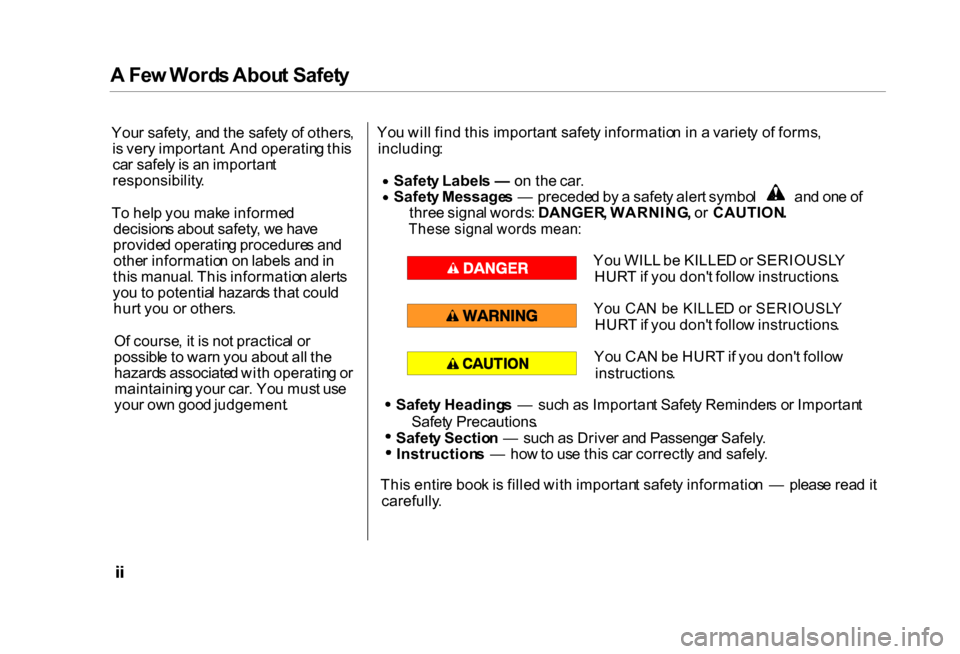
A
Fe w Word s Abou t Safet y
You r safety , an d th e safet y o f others ,
i s ver y important . An d operatin g thi s
ca r safel y is a n importan t
responsibility .
T o hel p yo u mak e informe d
decision s abou t safety , w e hav e
provide d operatin g procedure s an d
othe r informatio n o n label s an d in
thi s manual . Thi s informatio n alert s
yo u to potentia l hazard s tha t coul d
hur t yo u o r others .
O f course , i t i s no t practica l o r
possibl e to war n yo u abou t al l th e
hazard s associate d wit h operatin g o r
maintainin g you r car . Yo u mus t us e
you r ow n goo d judgement . Yo
u wil l fin d thi s importan t safet y informatio n in a variet y o f forms ,
including :
Safet y Label s — on th e car . Safet
y Message s — precede d b y a safet y aler t symbo l an d on e o f
thre e signa l words : DANGER , WARNING ,
o r CAUTION .
Thes e signa l
word
s mean :
Yo u WIL L b e KILLE D o r SERIOUSL Y
HUR T if yo u don' t follo w instructions .
Yo u CA N b e KILLE D o r SERIOUSL Y
HUR T if yo u don' t follo w instructions .
Yo u CA N b e HUR T if yo u don' t follo w
instructions .
Safet y Heading s — suc h a s Importan t Safet y Reminder s o r Importan t
Safet y Precautions .
Safet y Sectio n — suc h a s Drive r an d Passenge r Safely . Instruction
s — ho w to us e thi s ca r correctl y an d safely .
Thi s entir e boo k is fille d wit h importan t safet y informatio n — pleas e rea d it
carefully .
Page 9 of 293
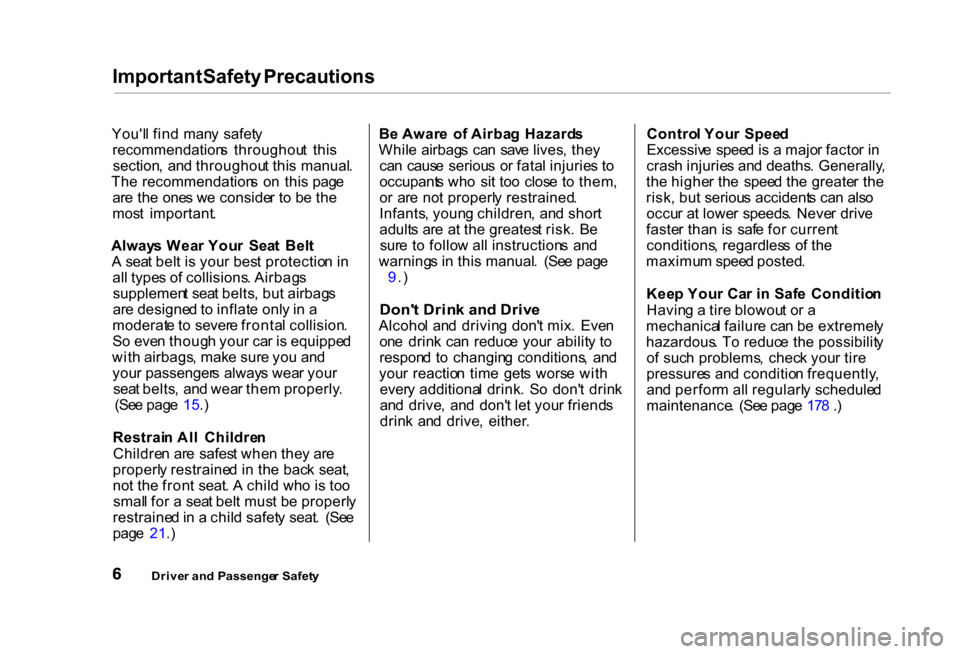
Important
Safety Precautions
You'l l fin d man y safet y
recommendation s throughou t thi s
section , an d throughou t thi s manual .
Th e recommendation s o n thi s pag e
ar e th e one s w e conside r t o b e th e
mos t important .
Alway s Wea r You r Sea t Bel t
A sea t bel t i s you r bes t protectio n i n
al l type s o f collisions . Airbag s
supplemen t sea t belts , bu t airbag s
ar e designe d t o inflat e onl y i n a
moderat e to sever e fronta l collision .
S o eve n thoug h you r ca r i s equippe d
wit h airbags , mak e sur e yo u an d
you r passenger s alway s wea r you r
sea t belts , an d wea r the m properly .
(Se e pag e 15 .)
Restrai n Al l Childre n
Childre n ar e safes t whe n the y ar e
properl y restraine d i n th e bac k seat ,
no t th e fron t seat . A chil d wh o i s to o
smal l fo r a sea t bel t mus t b e properl y
restraine d in a chil d safet y seat . (Se e
pag e 21 .) B
e Awar e o f Airba g Hazard s
Whil e airbag s ca n sav e lives , the y
ca n caus e seriou s o r fata l injurie s t o
occupant s wh o si t to o clos e t o them ,
o r ar e no t properl y restrained .
Infants , youn g children , an d shor t
adult s ar e a t th e greates t risk . B e
sur e t o follo w al l instruction s an d
warning s i n thi s manual . (Se e pag e
9 .)
Don' t Drin k an d Driv e
Alcoho l an d drivin g don' t mix . Eve n
on e drin k ca n reduc e you r abilit y t o
respon d t o changin g conditions , an d
you r reactio n tim e get s wors e wit h
ever y additiona l drink . S o don' t drin k
an d drive , an d don' t le t you r friend s
drin k an d drive , either . Contro
l You r Spee d
Excessiv e spee d is a majo r facto r i n
cras h injurie s an d deaths . Generally ,
th e highe r th e spee d th e greate r th e
risk , bu t seriou s accident s ca n als o
occu r a t lowe r speeds . Neve r driv e
faste r tha n i s saf e fo r curren t
conditions , regardles s o f th e
maximu m spee d posted .
Kee p You r Ca r i n Saf e Conditio n
Havin g a tir e blowou t o r a
mechanica l failur e ca n b e extremel y
hazardous . T o reduc e th e possibilit y
o f suc h problems , chec k you r tir e
pressure s an d conditio n frequently ,
an d perfor m al l regularl y schedule d
maintenance . (Se e pag e 17 8 .)
Drive r an d Passenge r Safet y
Page 54 of 293

Instrument
s an d Control s
Thi s sectio n give s informatio n abou t
th e control s an d display s tha t
contribut e t o th e dail y operatio n o f
you r Honda . Al l th e essentia l
control s ar e withi n eas y reach .
Contro
l Locations........................... . 5 2
Indicato r Lights............................... . 5 3
Gauges............................................. . 5 7
Speedometer............................... . 5 7
Tachometer................................. . 5 7
Odometer..................................... . 5 7
Tri p Meter................................... . 5 7
Fue l Gauge.................................. . 5 8
Temperatur e Gauge................... . 5 8
Maintenanc e Require d
Indicator................................... . 5 9
Control s Nea r th e Steerin g
Wheel....................................... . 6 0
Headlights................................... . 6 1
Daytim e Runnin g Lights............ . 6 1
Instrumen t Pane l Brightness.... . 6 2
Tur n Signals................................ . 6 2
Windshiel d Wipers..................... . 6 3
Windshiel d Washers.................. . 6 3
Hazar d Warning.......................... . 6 4
Rea r Windo w Defogger............. . 6 4
Steerin g Whee l Adjustment...... . 6 5
Steerin g Whee l Control s ............... . 6 6
Cruis e Control............................. . 6 6
Key s an d Locks............................... . 6 9
Keys............................................... 69
Ignitio
n Switch............................ . 7 0
Doo r Locks.................................. . 7 1
Powe r Doo r Locks...................... . 7 2
Remot e Transmitter................... . 7 3
Childproo f Doo r Locks.............. . 7 5
Trunk........................................... . 7 6
Sea t Adjustments............................ . 7 7
Fron t Sea t Adjustments............. . 7 7
Driver' s Sea t Heigh t
Adjustment.............................. . 7 8
Hea d Restraints.......................... . 7 9
Foldin g Rea r Seat........................... . 8 0
Powe r Windows.............................. . 8 1
Moonroof......................................... . 8 3
Mirrors............................................. . 8 3
Adjustin g th e Powe r Mirrors.... . 8 4
Parkin g Brake................................. . 8 5
Glov e Box........................................ . 8 6
Beverag e Holder............................. . 8 6
Accessor y Powe r Socket............... . 8 7
Ashtrays........................................... . 8 7
Interio r Lights................................. . 8 8
Ceilin g Light................................ . 8 8
Spotlights..................................... . 8 8
Instrument s an d Control s
Page 80 of 293
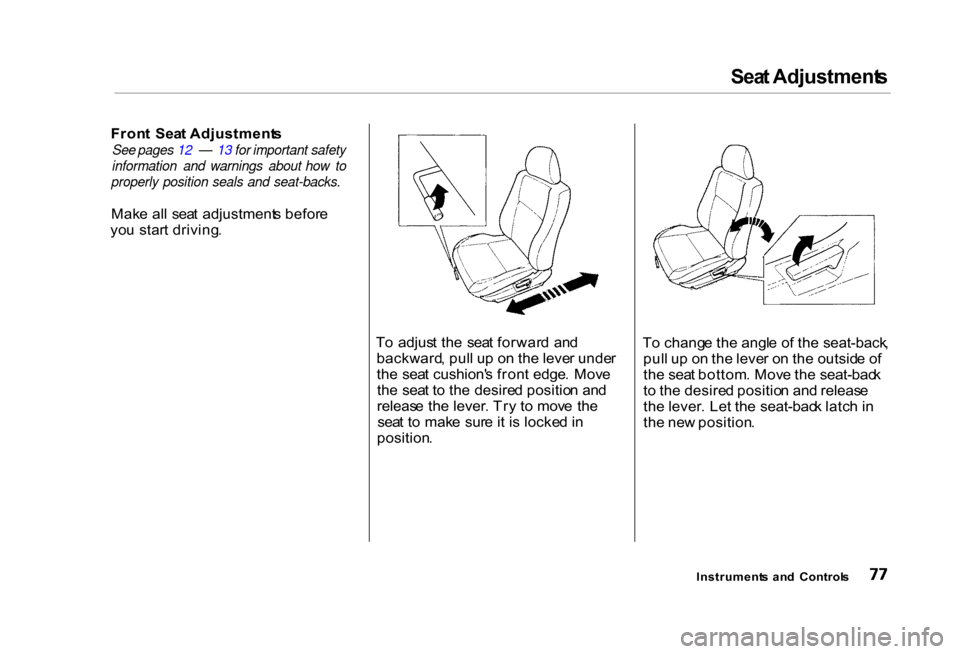
Sea
t Adjustment s
Fron t Sea t Adjustment s
See pages 12 — 13 for important safety
information and warnings about how to
properly position seals and seat-backs.
Mak e al l sea t adjustment s befor e
yo u star t driving .
To adjus t th e sea t forwar d an d
backward , pul l u p o n th e leve r unde r
th e sea t cushion' s fron t edge . Mov e
th e sea t t o th e desire d positio n an d
releas e th e lever . Tr y t o mov e th e
sea t t o mak e sur e it i s locke d in
position . T
o chang e th e angl e o f th e seat-back ,
pul l u p o n th e leve r o n th e outsid e o f
th e sea t bottom . Mov e th e seat-bac k
t o th e desire d positio n an d releas e
th e lever . Le t th e seat-bac k latc h in
th e ne w position .
Instrument s an d Control s
Page 82 of 293
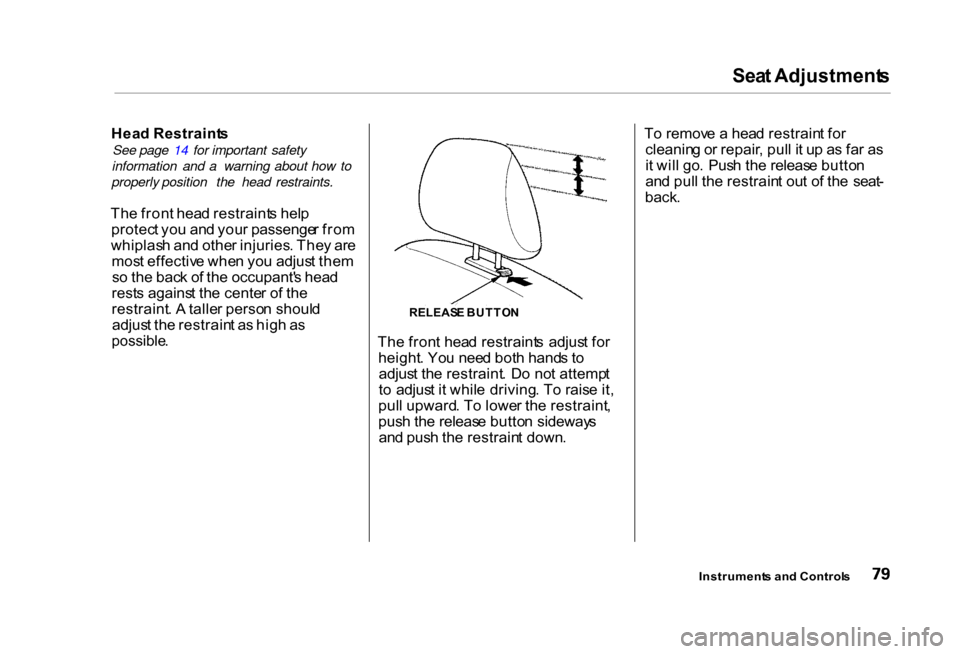
Sea
t Adjustment s
Hea d Restraint s
See page 14 for important safety
information and a warning about how to
properly position the head restraints.
Th e fron t hea d restraint s hel p
protec t yo u an d you r passenge r fro m
whiplas h an d othe r injuries . The y ar e
mos t effectiv e whe n yo u adjus t the m
s o th e bac k o f th e occupant' s hea d
rest s agains t th e cente r o f th e
restraint . A talle r perso n shoul d
adjus t th e restrain t a s hig h a s
possible .
The fron t hea d restraint s adjus t fo r
height . Yo u nee d bot h hand s t o
adjus t th e restraint . D o no t attemp t
t o adjus t i t whil e driving . T o rais e it ,
pul l upward . T o lowe r th e restraint ,
pus h th e releas e butto n sideway s
an d pus h th e restrain t down . T
o remov e a hea d restrain t fo r
cleanin g o r repair , pul l i t u p a s fa r a s
i t wil l go . Pus h th e releas e butto n
an d pul l th e restrain t ou t o f th e seat -
back .
Instrument s an d Control s
RELEAS
E BUTTO N
Page 174 of 293
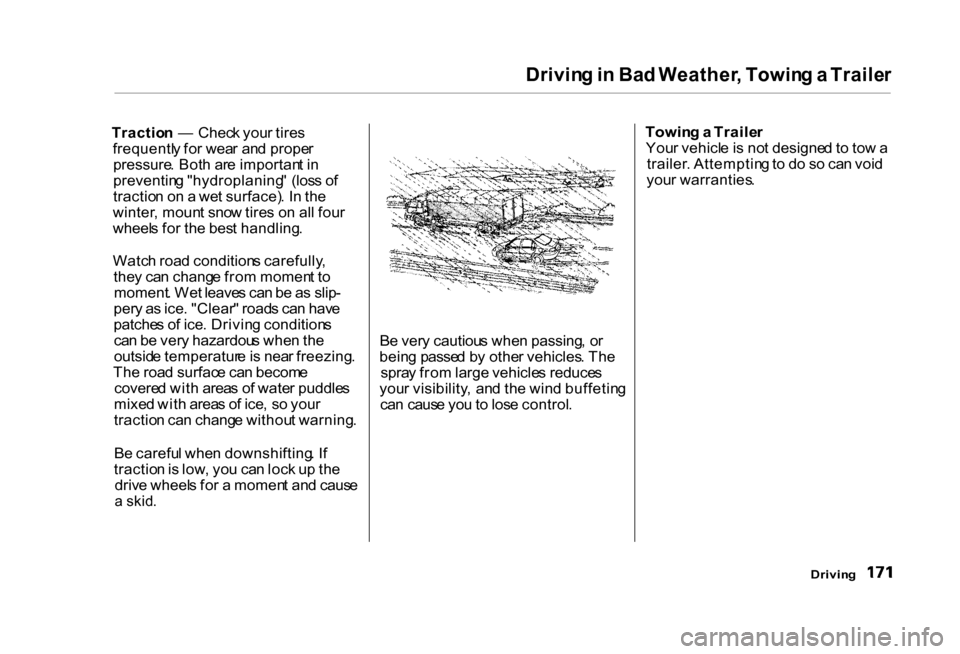
Drivin
g in Ba d Weather , Towin g a Traile r
Tractio n — Chec k you r tire s
frequentl y fo r wea r an d prope r
pressure . Bot h ar e importan t i n
preventin g "hydroplaning " (los s o f
tractio n o n a we t surface) . I n th e
winter , moun t sno w tire s o n al l fou r
wheel s fo r th e bes t handling .
Watc h roa d condition s carefully ,
the y ca n chang e fro m momen t t o
moment . We t leave s ca n b e a s slip -
per y a s ice . "Clear " road s ca n hav e
patche s o f ice . Drivin g condition s
ca n b e ver y hazardou s whe n th e
outsid e temperatur e is nea r freezing .
Th e roa d surfac e ca n becom e
covere d wit h area s o f wate r puddle s
mixe d wit h area s o f ice , s o you r
tractio n ca n chang e withou t warning .
B e carefu l whe n downshifting . I f
tractio n is low , yo u ca n loc k u p th e
driv e wheel s fo r a momen t an d caus e
a skid .
B
e ver y cautiou s whe n passing , o r
bein g passe d b y othe r vehicles . Th e
spra y fro m large vehicle s reduce s
you r visibility , an d th e win d buffetin g
ca n caus e yo u to los e control .
Towin
g a Traile r
You r vehicl e is no t designe d to to w a
trailer . Attemptin g to d o s o ca n voi d
you r warranties .
Driving
Page 269 of 293
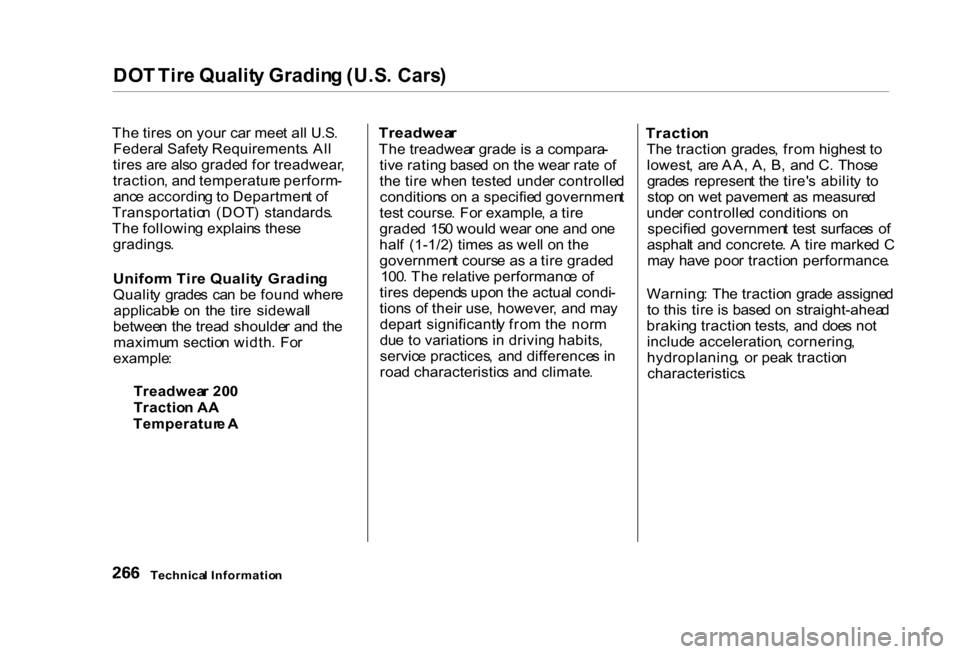
DO
T Tir e Qualit y Gradin g (U.S . Cars )
Th e tire s o n you r ca r mee t al l U.S .
Federa l Safet y Requirements . Al l
tire s ar e als o grade d fo r treadwear ,
traction , an d temperatur e perform -
anc e accordin g to Departmen t o f
Transportatio n (DOT ) standards .
Th e followin g explain s thes e
gradings .
Unifor m Tir e Qualit y Gradin g
Qualit y grade s ca n b e foun d wher e
applicabl e o n th e tir e sidewal l
betwee n th e trea d shoulde r an d th e
maximu m sectio n width . Fo r
example :
Treadwea r 20 0
Tractio n A A
Temperatur e A
Treadwea
r
Th e treadwea r grad e is a compara -
tiv e ratin g base d o n th e wea r rat e o f
th e tir e whe n teste d unde r controlle d
condition s o n a specifie d governmen t
tes t course . Fo r example , a tir e
grade d 15 0 woul d wea r on e an d on e
hal f (1-1/2 ) time s a s wel l o n th e
governmen t cours e a s a tir e grade d
100 . Th e relativ e performanc e o f
tire s depend s upo n th e actua l condi -
tion s o f thei r use , however , an d ma y
depar t significantl y fro m th e nor m
du e t o variation s i n drivin g habits ,
servic e practices , an d difference s i n
roa d characteristic s an d climate .
Tractio
n
Th e tractio n grades , fro m highes t t o
lowest , ar e AA , A , B , an d C . Thos e
grade s represen t th e tire' s abilit y t o
sto p o n we t pavemen t a s measure d
unde r controlle d condition s o n
specifie d governmen t tes t surface s o f
asphal t an d concrete . A tir e marke d C
ma y hav e poo r tractio n performance .
Warning : Th e tractio n grad e assigne d
t o thi s tir e is base d o n straight-ahea d
brakin g tractio n tests , an d doe s no t
includ e acceleration , cornering ,
hydroplaning , o r pea k tractio n
characteristics .
Technica l Informatio n
Page 270 of 293
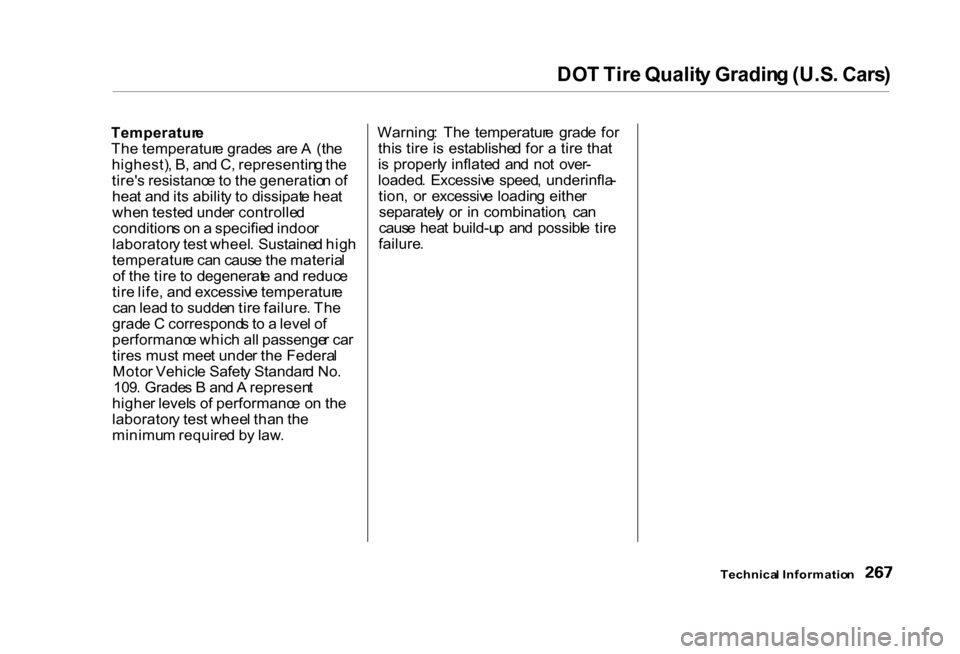
DO
T Tir e Qualit y Gradin g (U.S . Cars )
Temperatur e
Th e temperatur e grade s ar e A (th e
highest) , B , an d C , representin g th e
tire' s resistanc e to th e generatio n o f
hea t an d it s abilit y t o dissipat e hea t
whe n teste d unde r controlle d
condition s o n a specifie d indoo r
laborator y tes t wheel . Sustaine d hig h
temperatur e ca n caus e th e materia l
o f th e tir e to degenerat e an d reduc e
tir e life , an d excessiv e temperatur e
ca n lea d to sudde n tir e failure . Th e
grad e C correspond s t o a leve l o f
performanc e whic h al l passenge r ca r
tire s mus t mee t unde r th e Federa l
Moto r Vehicl e Safet y Standar d No .
109 . Grade s B an d A represen t
highe r level s o f performanc e o n th e
laborator y tes t whee l tha n th e
minimu m require d b y law . Warning
: Th e temperatur e grad e fo r
thi s tir e i s establishe d fo r a tir e tha t
i s properl y inflate d an d no t over -
loaded . Excessiv e speed , underinfla -
tion , o r excessiv e loadin g eithe r
separatel y o r i n combination , ca n
caus e hea t build-u p an d possibl e tir e
failure .
Technical Informatio n